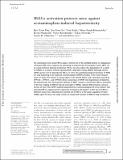| dc.contributor.author | Hur, Kyu Yeon | |
| dc.contributor.author | So, Jae-Seon | |
| dc.contributor.author | Frank-Kamenetsky, Maria | |
| dc.contributor.author | Fitzgerald, Kevin | |
| dc.contributor.author | Kotelianski, Victor E. | |
| dc.contributor.author | Iwawaki, Takao | |
| dc.contributor.author | Lee, Ann-Hwee | |
| dc.contributor.author | Ruda, Vera | |
| dc.contributor.author | Glimcher, Laurie H | |
| dc.date.accessioned | 2012-05-04T21:42:37Z | |
| dc.date.available | 2012-05-04T21:42:37Z | |
| dc.date.issued | 2012-01 | |
| dc.date.submitted | 2011-06 | |
| dc.identifier.issn | 0022-1007 | |
| dc.identifier.issn | 1540-9538 | |
| dc.identifier.uri | http://hdl.handle.net/1721.1/70518 | |
| dc.description | Online supplemental material. Table S1 shows the expression of genes
related to drug metabolism in XBP1-deficient liver. Online supplemental material
is available at http://www.jem.org/cgi/content/full/jem.20111298/DC1. | en_US |
| dc.description.abstract | The mammalian stress sensor IRE1α plays a central role in the unfolded protein, or endoplasmic reticulum (ER), stress response by activating its downstream transcription factor XBP1 via an unconventional splicing mechanism. IRE1α can also induce the degradation of a subset of mRNAs in a process termed regulated IRE1-dependent decay (RIDD). Although diverse mRNA species can be degraded by IRE1α in vitro, the pathophysiological functions of RIDD are only beginning to be explored. Acetaminophen (APAP) overdose is the most frequent cause of acute liver failure in young adults in the United States and is primarily caused by CYP1A2-, CYP2E1-, and CYP3A4-driven conversion of APAP into hepatotoxic metabolites. We demonstrate here that genetic ablation of XBP1 results in constitutive IRE1α activation in the liver, leading to RIDD of Cyp1a2 and Cyp2e1 mRNAs, reduced JNK activation, and protection of mice from APAP-induced hepatotoxicity. A pharmacological ER stress inducer that activated IRE1α suppressed the expression of Cyp1a2 and Cyp2e1 in WT, but not IRE1α-deficient mouse liver, indicating the essential role of IRE1α in the down-regulation of these mRNAs upon ER stress. Our study reveals an unexpected function of RIDD in drug metabolism. | en_US |
| dc.description.sponsorship | National Institutes of Health (U.S.) (grant AI32412) | en_US |
| dc.description.sponsorship | National Institutes of Health (U.S.) (grant DK082448) | en_US |
| dc.description.sponsorship | National Institutes of Health (U.S.) (grant DK089211) | en_US |
| dc.description.sponsorship | American Heart Association | en_US |
| dc.language.iso | en_US | |
| dc.publisher | Rockefeller University Press, The | en_US |
| dc.relation.isversionof | http://dx.doi.org/10.1084/jem.20111298 | en_US |
| dc.rights | Creative Commons Attribution-Noncommercial-Share Alike 3.0 Unported | en_US |
| dc.rights.uri | http://creativecommons.org/licenses/by-nc-sa/3.0/ | en_US |
| dc.source | Rockefeller UP | en_US |
| dc.title | IRE1α activation protects mice against acetaminophen-induced hepatotoxicity | en_US |
| dc.type | Article | en_US |
| dc.identifier.citation | Hur, K. Y. et al. “IRE1 Activation Protects Mice Against Acetaminophen-induced Hepatotoxicity.” Journal of Experimental Medicine 209.2 (2012): 307–318. Web. 4 May 2012. | en_US |
| dc.contributor.department | Ragon Institute of MGH, MIT and Harvard | en_US |
| dc.contributor.department | Koch Institute for Integrative Cancer Research at MIT | en_US |
| dc.contributor.approver | Ruda, Vera | |
| dc.contributor.mitauthor | Ruda, Vera | |
| dc.contributor.mitauthor | Glimcher, Laurie H. | |
| dc.relation.journal | Journal of Experimental Medicine | en_US |
| dc.eprint.version | Final published version | en_US |
| dc.type.uri | http://purl.org/eprint/type/JournalArticle | en_US |
| eprint.status | http://purl.org/eprint/status/PeerReviewed | en_US |
| dspace.orderedauthors | Hur, K. Y.; So, J.-S.; Ruda, V.; Frank-Kamenetsky, M.; Fitzgerald, K.; Koteliansky, V.; Iwawaki, T.; Glimcher, L. H.; Lee, A.-H. | en |
| mit.license | PUBLISHER_CC | en_US |
| mit.metadata.status | Complete | |
